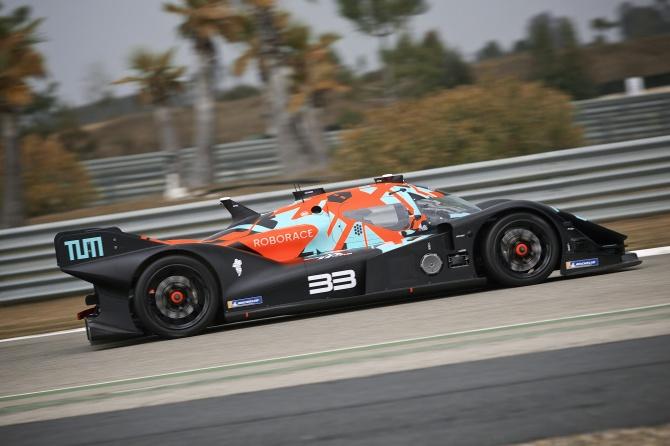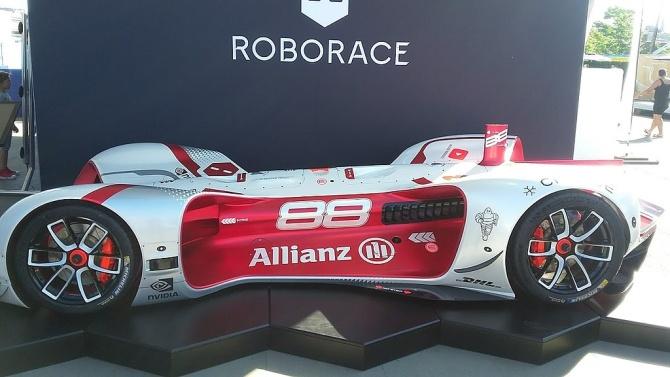DevBot 2.0, an electrically powered vehicle with all sorts of smart sensory equipment and an integrated computer, is just the beginning. Autonomous vehicles will become more and more common as the technology improves, says Devangshu Datta.

Pick any two cars out of the same assembly line. Ask two drivers to race the same course. The better driver will win. Now, go one step further.
Take several models of the same car, with the same specifications, and invite different teams to race these by creating their own Artificial Intelligence (AI) driving software.
The best driver will still win! Only this time, it won't be human.
This is the Roborace concept -- a competitive racing circuit, which is also a technology demonstrator.
The cars used in the first season ("Season Alpha") are designed by Daniel Simon.
Simon has worked with Volkswagen and Bugatti and the Hispania F1 team.
But he's best known for designing the futuristic vehicles that featured in science-fiction/fantasy movies like Tron: Legacy, Captain America: The First Avenger and Oblivion.
The car is the DevBot 2.0. This is an electrically powered vehicle with all sorts of smart sensory equipment and an integrated computer.
Roborace is a spinoff from Formula E -- the circuit for electrically-powered cars.
Season Alpha runs as a prequel to Formula E races. It's overseen by the FIA -- the Federation Internationale de l'Automobile, the same body that handles all formula racing.
The CEO of Roborace is Brazilian Formula E champion, Lucas Tucci di Grass.
Roborace is backed by Kinetik, a venture capital firm registered in Luxembourg, founded by Russian billionaire, Denis Sverdlov.
Sverdlov also owns Arrival, a British firm that builds electric trucks.

DevBot 2 looks gorgeous, with a classic teardrop-shaped Le Mans Prototype (LMP) chassis.
It weighs about 1,350 kg and is 4.8 metres long and 2 metres wide but just 85 cm high.
It has four electric motors, each capable of generating 300 kilowatts, and it uses a 840V battery. It's a rear-wheel drive.
For navigation, the car relies on overkill. The mix of two radars, five LIDARs (laser-based versions of radar), 18 ultrasonic sensors, two optical speed sensors and six AI-controlled cameras offers 360-degree "vision".
The navigation uses GNSS (Global Navigation Satellite Systems), which means that it can use any and every available satellite navigation network.
The design team claims that if a coin is placed somewhere on a road, the car can drive over that repeatedly.
Michelin supplies the tyres and graphics chip giant NVIDIA the hardware.
The onboard computer is the NVIDIA Drive PX-2, an AI configuration based on TEGRA gaming chips. This is the industry standard for driverless cars.
The Drive PX-2 can handle up to 3.2 trillion deep learning operations per second -- which gives you an idea of how complex driverless software is.
The computer has an API (Application Programming Interface). This allows programmers to easily upload their preferred AI driver and the real-time computing algorithms that process the humongous data from all those sensors.
DevBot 2 has been demonstrated to hit 299 kph in test drives and it has a claimed top speed of 320 kph.
The last two years have been spent putting it through its paces. Season Alpha will not be driverless.
There is a cockpit and drivers will take the wheel for part of every race.
Di Grass claims that this is partly a PR exercise -- racing fans prefer to see somebody in the car, even if he or she isn't actually doing anything.
A (good) driver taking control for the first lap also helps the AI learn how to drive challenging circuits.
In human and AI comparison trials last year, the best humans beat the AIs.
But that could be reversed, as the AIs learn and become better drivers.
A human driver can always take over if something goes wrong, though it's a moot point whether human reflexes will be good enough to correct errors at those speeds.
At a demonstration in Argentina in February 2017, there was a disaster as a driverless vehicle slammed into a wall.
However, that very same vehicle had just successfully avoided a dog wandering around the track.
This is an important learning experience. The AI must cope with different weather and visibility, and handle difficult circuits.
It needs to operate at high speeds as it takes the decisions humans handle without conscious thought. When should it overtake? How will other cars behave?
The onboard software also publishes all that data and the decision-making processes in real time.
Engineers can parse those decisions for information on how to improve. The cars can also communicate with each other.
This could be a key factor when it comes to putting fleets of autonomous vehicles on the street.

The first Season Alpha race took place in May on the Monteblanco circuit in Spain where the Technical University of Munich competed against the University of Pisa.
This was entirely driverless. Later races will probably feature more teams as Formula E moves to Italy, UK, Hungary and America.
Autonomous vehicles will become more and more common as the technology improves.
Most modern autonomous cars and trucks are "Level Three": the car can do the driving but the driver must be on standby.
Level Four is defined as a car that's capable of driving itself completely hands-off, provided it is very familiar with the specific road system. Level Five vehicles won't even need steering wheels.
There could be many advantages to Level Five vehicles taking over. Most accidents are due to human error.
Accidents caused by drivers being tired, drunk, distracted or taking risks would not occur.
If every car can talk to every other car, risks are also vastly reduced, even if many cars are moving at high speeds, maintaining minimal braking distance on roads with blind turns. This means faster commutes.
Braess's Paradox is a well-known problem: travel time can actually increase when new roads are added to a network, even though traffic volume remains the same.
This is because most human drivers take what they consider the optimal route. Given autonomous vehicles that talk to each other in real time, Braess's paradox could be eliminated.
All cars could coordinate to take routes that ensure optimal travel time for all vehicles.
Autonomous cars would also be more cost-effective 24x7 taxis, since the driver doesn't take breaks.
Similarly, autonomous trucks may carry cargo more efficiently. Indeed, there are already fleets of these in operation in the US and Europe, travelling mostly on access-controlled highways, with a "passenger" to deal with paperwork and any emergency.
Going further, if vehicles are redesigned without steering wheels and dashboards, you could have mobile offices, with desks and chairs placed in different configurations.
That would allow commuters to work as they travel, potentially altering workplace dynamics.
Of course, all this will mean a huge shift in employment patterns as millions of driving jobs are eliminated.
This will be a gradual, accelerating process, going by the rate of AI's progress in other domains.
Learning to deal with the chaos on Indian roads might be the final frontier for driverless cars.
But it's bound to happen, and initiatives like the Roborace circuit are a vital part of the learning curve.











